

The BARR Way

The BARR Way Mantra
1
Question every requirement
Never accept that a process or requirement came from a department, such as from “legal”, “the quality department”, or “the CEO”. You need to know the name of the real name of the person who made that requirement and question it, no matter how smart that person is or how widely adopted a practice guide is.
2
3 4 5
Delete any part or process you can
Simplify and optimize leveraging the five leadership abilities
Accelerate cycle time
Automate

Proven Processes (Front Stage)
Attest Proven Processes
General Examination Engagement
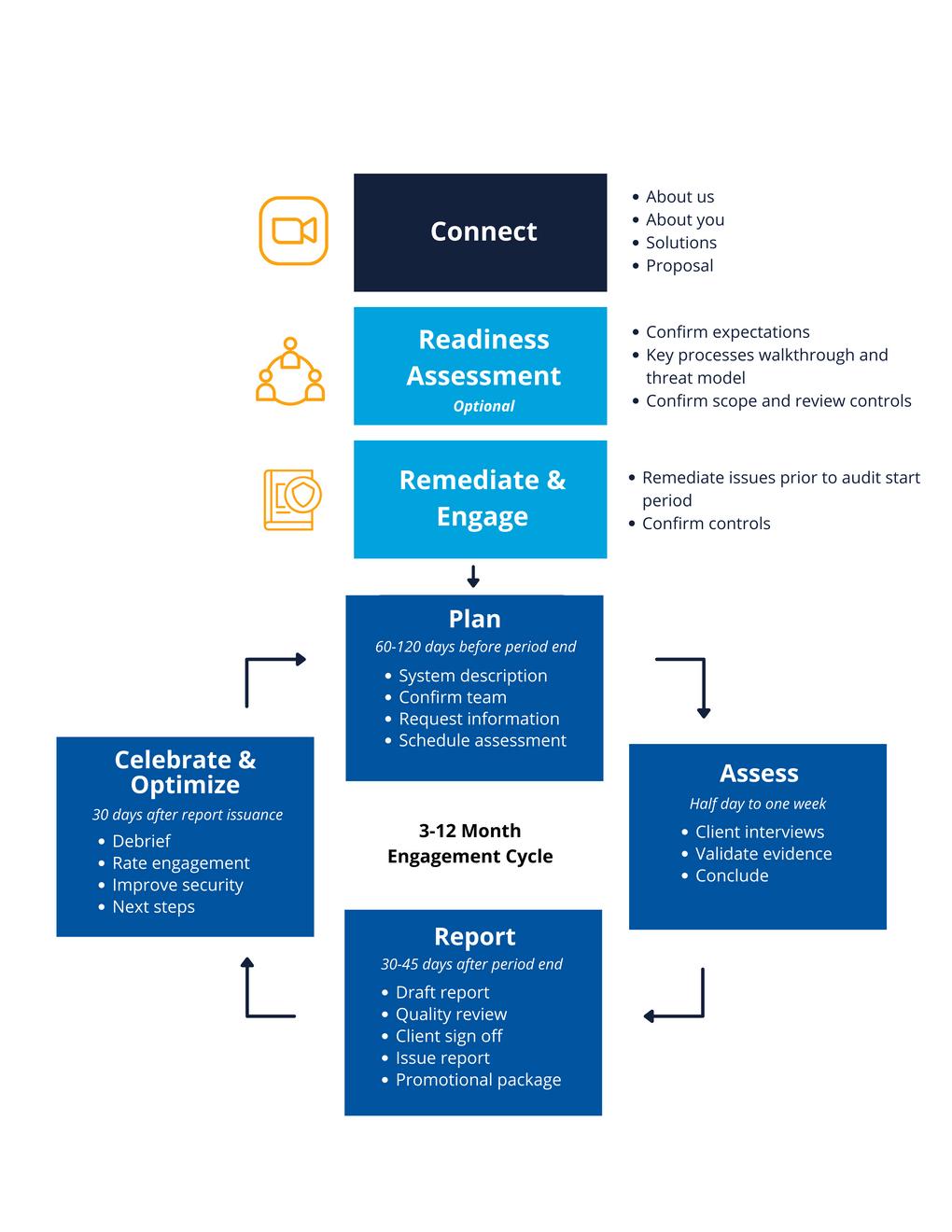
Connect
After we connect on a 30-minute call to determine a prospect’s needs, including the timing of their examination engagement, BARR will send an engagement letter within one day to confirm our understanding. We guarantee client satisfaction.
Readiness
The readiness assessment provides three deliverables to assess readiness to begin the audit: System Scope, Prioritization of Gaps, and Key Controls This is accomplished as follows:
Readiness Meeting #1: Client will meet with their BARR engagement manager, share a system demo, and confirm scope and expectations.
Readiness Meeting #2+: In this 2+ hour meeting, we will review a client’s key processes such as change management, access management, and vulnerability management.
Readiness Meeting #3: A debrief meeting to confirm the three readiness deliverables
Remediate & Engage: Client will correct gaps prior to starting the audit period
Examination Engagement
Plan: A kick off call is scheduled with the client to confirm we’re on the same page with the scope, timelines, deliverables, and personnel needed for the assessment The client will be responsible for confirming control wording and drafting the system description BARR will provide information requests based on the agreed scope and controls
Assess: The engagement team will schedule walkthroughs with the client to assess the controls and any preliminary issues. Everyone’s time is valuable. To make efficient use of time, BARR will review provided information requests and control activity in compliance automation software (if available) prior to walkthroughs Walkthrough duration is dependent on the environment complexity and size; however, four hours is the typical time commitment
Report: BARR will provide a draft report including feedback on the system description based on BARR’s knowledge of the system and control environment no later than 30 days after period end. Once reviewed by the client, BARR performs a final editorial and quality reviews After you sign off on the management representation letter, the report is issued
Celebrate & Optimize: BARR will provide a promotional package and schedule a debrief to review improvement opportunities for their client’s security program, rate the engagement, and plan the next engagement.
Certification to ISO Standards
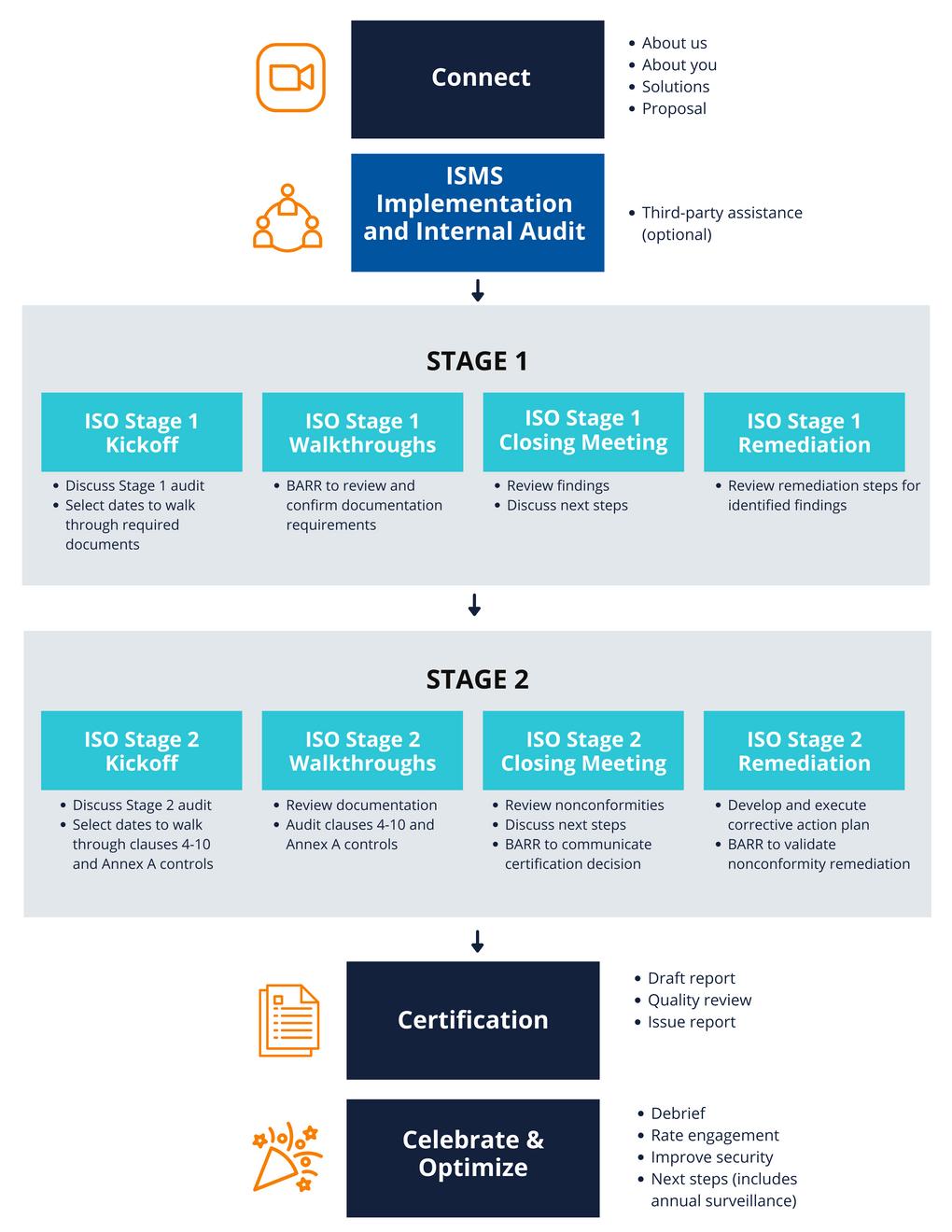
Internal Audit - The prospect is responsible for, and required to get an internal audit prior to kicking off stage 1 The internal audit can be completed by an outside firm or an independent resource within the prospect’s organization who is not the control owner and not responsible for the team's ISMS
Deliverables from the internal audit include:
Statement of Applicability
Risk Assessment
List of major and minor non-conformities
Stage 1: ISMS Review - BARR will conduct a review of the ISMS based on ISO Clauses 4-10 This stage is focused on the enterprise level controls and environment, such as key policies and procedures
Stage 2: Annex A Controls - BARR will conduct a review of the client’s Annex A controls, or customized controls based on the statement of applicability (if available), in a live setting, to test for effectiveness.
Certification Issuance - We can issue the ISO 27001 certification once stage 2 has been completed. If the client has a major non-conformity that was found during stage 1 or 2. This must be closed before issuance If a minor non-conformity is found, we can issue the certification as long as there's a project plan in place to close the minor non-conformity
Subsequent Surveillance Audits - In the subsequent 2 years following the initial certification, BARR will perform surveillance audits. This consists of a review of the team's ISMS (i.e. Stage 1) as well as a check on ⅓ of the Annex A controls.
Timing- The audit days that we will spend on the client primarily depends on their headcount in relation to their ISMS Please refer to the ANAB audit days chart here (use ISMS column)
HITRUST
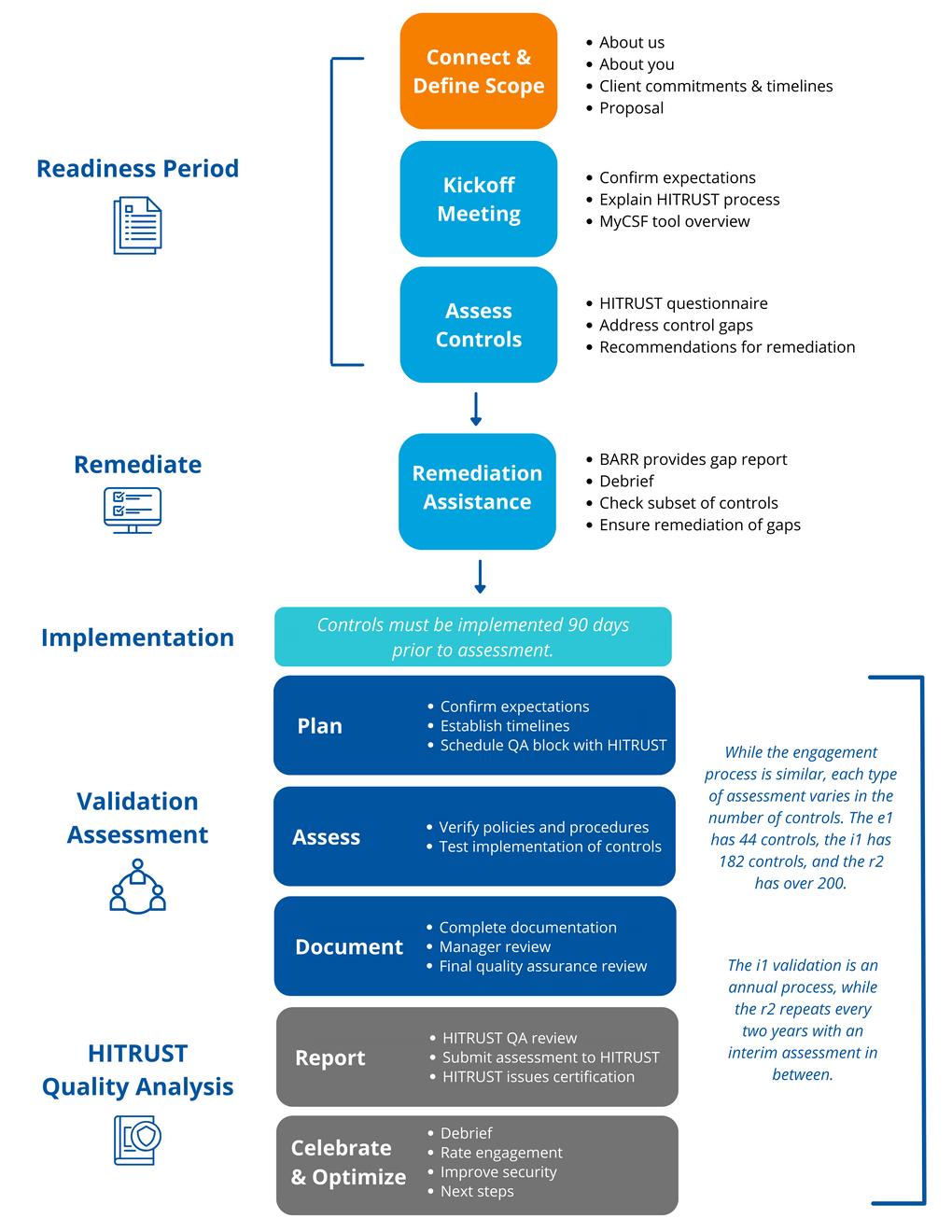
Consulting Proven Processes
Objective
The Cybersecurity Consulting team establishes cybersecurity programs that are flexible and adaptive to the needs of the client and relevant stakeholders. This includes a common structure to establish a demonstrable cybersecurity program and streamline the sales cycle with client customer security demands. Our approach includes the following phases, activities, and deliverables.
Phase 1: Gap Assessment and Remediation (2-4 months)
BARR believes in determining the why before proposing the how and that careful planning is imperative to help our clients achieve their business objectives by managing their cybersecurity and compliance demands. When we start working with a new client that we are implementing a cybersecurity program, we first perform a gap assessment and then help clients remediate their gaps and establish a cybersecurity program. Not all clients will follow this process exactly and engagement teams will modify the approach based on statements of work and in-scope services
Cybersecurity Gap Assessment
We help our clients identify gaps and provide a roadmap to implementing a sustainable and right-sized cybersecurity program When assessing a client’s cybersecurity posture, we follow the steps below
Step 1: Connect and Determine Scope: Once we have a signed contract or statement of work, we begin the process by connecting with the client and determining the scope of our engagement. This includes the following steps:
1. Prepare assessment documents, including gap assessment workbook, agendas, request lists and send these to the client
Onboard the client, including setting them up in BARR’s systems (e.g., Kantata, Google Workspace, etc.) and introducing the BARR team to the client team
2 Perform a kickoff meeting with the client to establish the goals, objectives, responsibilities, and timeline of the engagement.
3. Facilitate collaborative discussions with the client to understand their business processes, regulatory requirements, and key risk areas to ensure we tailor our assessment to the client’s unique needs and document our initial scope, including:
4. People Processes Technology Data Location(s) Assessment framework and criteria
5 Document the initial scope and communicate this to the client
Note: we will finalize the scope as part of step 3 below
Step 2: Assess the Client: We conduct a thorough and comprehensive cybersecurity assessment of the client’s existing cybersecurity program against best practices and the frameworks and criteria established during the scoping process. This process includes the following steps:
1
System walkthroughs and observations, interviews with key personnel, document reviews, and technical evaluations
2 Initial drafting of the deliverables, which are finalized in the step below.
Document the results of the assessment, including a result for each in-scope criteria or requirement and a description of any gaps identified during the process.
3.
Step 3: Prepare and Finalize Deliverables: Compile the findings from the assessment into a formal report to clearly outline identified gaps, areas of non-compliance, and potential vulnerabilities This report includes the following information:
1
High-level scope definition of the client based on the people, processes, and technology identified in the assessment process.
2. Prioritized list of gaps and recommendations to remediate them, including a:
Detailed description of the gap
Recommendation to remediate the gap
Proposed remediation plan
Priority ranking based on impact to controls or in-scope criteria
Owner(s) of each remediation plan
3. Initial set of controls, aligned with the in-scope criteria and best practices.
BARR also provides an executive summary, typically in the form of a slide deck, to use when presenting the results to an executive team or other interested parties that don’t require the details of the gap assessment report
Step 4: Debrief and Plan: Conduct a debrief session with the client to discuss the findings, recommendations, and next steps. This involves a detailed walkthrough of the report to provide clarification of any client concerns, assign ownership of the remediation activities, and discuss a plan to carry those activities out. This includes a project management plan between BARR and the client to determine how we will monitor and report on progress throughout the remediation process
Remediation
Once we’ve completed the gap assessment BARR helps the client remediate gaps and move forward on their roadmap to an implemented cybersecurity program. The goal of this phase is to help the client reach its desired cybersecurity and compliance state, including remediating gaps from our assessment.
Remediation activities will vary from client to client, but, in most engagements BARR will:
1
Establish a Security Committee: Form a security team between BARR, the client, and other partners We want representatives from each department and a designated CISO to own the program and team. Document and assign team members’ responsibilities, including BARR’s responsibilities and limitations.
2 Project Management: Ensure all gaps and recommendations progress toward remediation and provide regular updates to the client team on that progress Support and manage remediation owners as requested and needed
3 Provide Remediation Deliverables: Complete BARR-owned remediation plans and provide those deliverables to the client. These will vary from client to client, we make sure the appropriate policies, procedures, documents, and controls are implemented. These may include:
Security team documents (e.g., Charter, resumes, responsibilities)
External-facing security package to help with customer security evaluations (e g , SIG Lite, Trustpage, etc )
Information security policies and procedures
Vendor reviews
Risk assessment documentation
4. Determine the approach moving forward: Once we’ve reached the remediated state, we establish processes for ongoing management of the client’s cybersecurity program. This involves setting up processes for regular monitoring, periodic assessments, and updates to the cybersecurity program and posture in response to evolving threats and compliance requirements We ensure the client’s organization has a sustainable cybersecurity program and manage it for them
Debrief with client personnel, including the executive sponsor, executive teams, and other parties
Documented long-term security plan based on everything above and including a process to monitor progress and provide updates to client leadership
Integrate BARR team with the client for efficiency and deepen the relationship
Confirm BARR’s responsibilities and portions of the program that we will manage moving forward
We will communicate budget and fees estimates to clients for phase 2
Phase 2: Cybersecurity Consulting (ongoing)
Once we’ve helped the client achieve their initial goals in phase 1, we move into an ongoing relationship with the client where we help manage their cybersecurity programs, including the specific services listed below. We may perform all of these services for the client, one of them, or any number in between. We may also perform these services for a client without going through a formal gap assessment. We document the in-scope services in our contracts and statements of work
vCISO advisory and leadership
Policies and procedures
Risk management
Incident response program management
Customer compliance questionnaires and security evaluations
User access reviews
Tabletop exercises for business continuity and incident response
Privacy assessments
Third-party risk management
Internal audits
Security awareness training
Penetration tests
External audit assistance
Managed compliance automation tools
Ad-hoc services as requested by the client
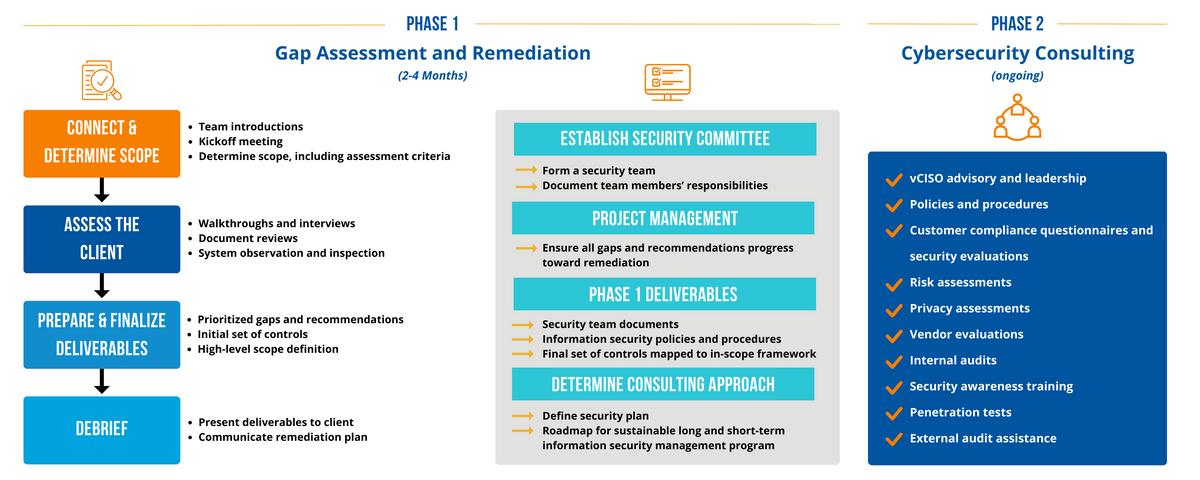
Core Processes (Back Stage)
Business Development & Marketing
Inbound Lead
Objective: Define the prospect journey to ensure each inbound lead is addressed the BARR Way.
Drive Awareness
1. SEO/SEM Sponsorships Content Marketing Events
PR Social Media Partnership Referral
Employee origination, etc
2. Incoming Lead
All sales Qualified Leads are sent to engage@barradvisory.com email group
Within 24 hours of receipt, the business development employee will round robin and perform the following:
Checks if lead automatically added in Hubspot
Adds lead and company information to Hubspot (if not already) and checks required Hubspot fields for accuracy (i e , lead source, stage, title, industry, website, etc )
Respond to the lead to schedule an initial call.
A sales team member will be notified by HubSpot when a lead schedules time on their calendar
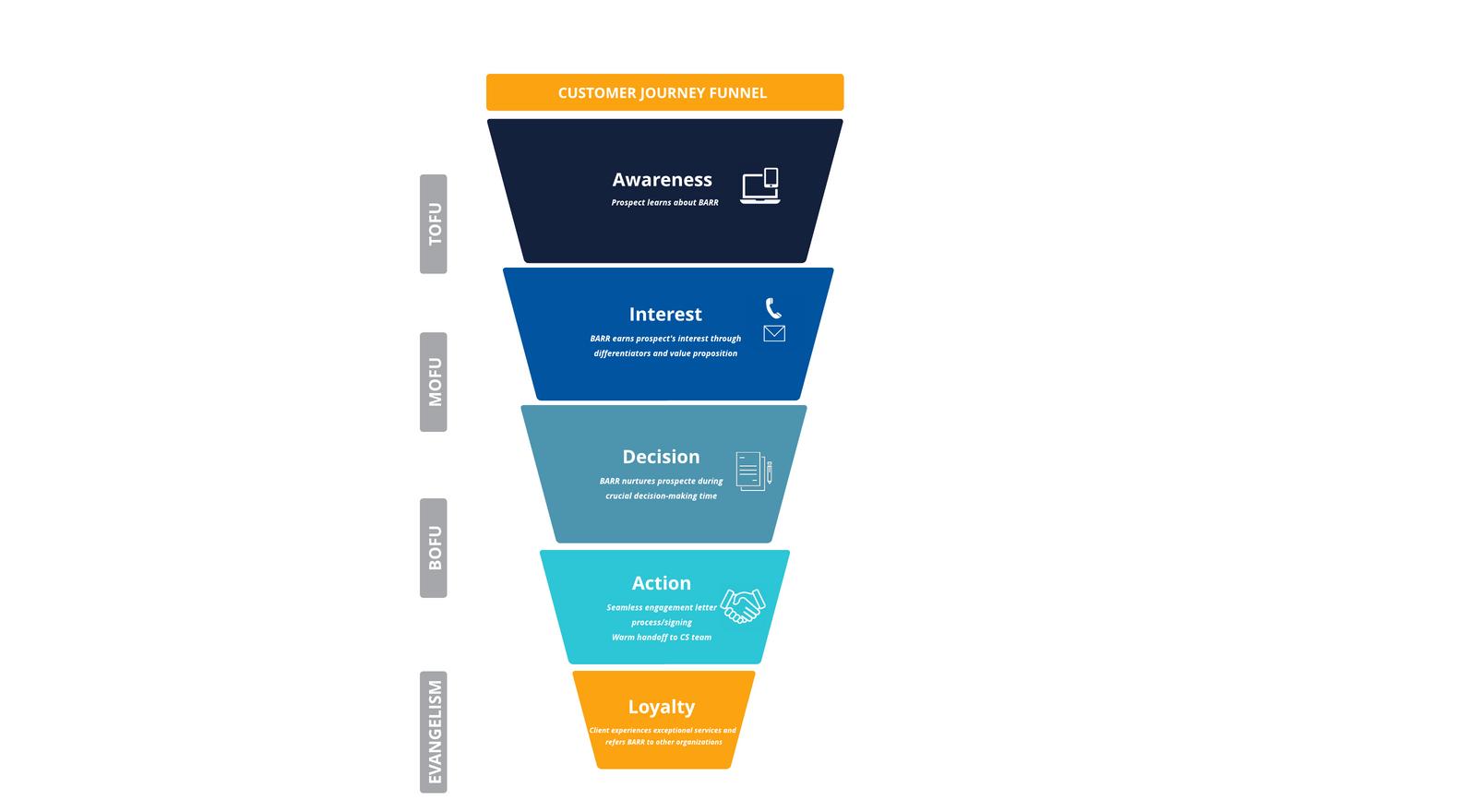
The team member adds their name as the Owner of the Contact and Company
The account executive adds a corresponding Deal into HubSpot within the corresponding Pipeline (New Business Attest or New Business Consulting) in the Conversation Scheduled stage
Core Processes (Back Stage)
Business Development & Marketing
Inbound Lead (continued)
3. Connect
About You (Discovery)
Learn about the prospect (what is important to them beyond a report, certification or consulting service)
Build trust and credibility
Sales Assistant sheets available in Marketing resource materials as needed (focus on them, not us)
About Us (Value and Process Communication)
Match prospect need to values and services BARR provides
Attest Sales Story / Consulting Sales Story
Proven process review
Confirm scope for pricing out the engagement.
Bring in partner or client service subject matter experts as needed
4. Pricing Proposal
Refer scope to Pricing Matrix to confirm the cost of the engagement
Receive price buy-in with Business Development or Client Service leadership
Send pricing and marketing deck within 24 hours of receiving scope from the prospect
For ISO prospects, send application
Update deal details and stage in Hubspot
5. Follow up and Close
Touchpoints via email and/or phone call at least once a week for 13 weeks (minimum requirement)
Sales team members use best judgment for how much attention and for how long that attention should be given to each individual prospect in their list.
If no contact is reciprocated by the prospect after 13 weeks, then the opportunity should be considered lost and the Deal should be moved to the Lost to Competitor stage
If lost, Marketing drip campaigns automatically trigger for re-engagement
6. Client and Engagement Acceptance and Continuance (CEAC)
Prospect verbally commits to price
CEAC completed (Attest Only)
Application reviewed and accepted by Attest ISO Application Reviewer (ISO only)
Sales team updates Hubspot deal details (timing, scope, etc.) and operation creates engagement letter
Timing and travel plans (if applicable) firmed up with prospect
CS Ops follows the steps outlined below for “New Business Pipeline” resourcing to ensure the project is able to be scheduled and Engagement Letter is drafted
Partner approves the engagement letter which is then sent to the prospect
Redline review, if any, is facilitated between the prospect and the BARR team
7. Client service handoff
Sales team member sends a thank you email to the client, copying the audit team (Partner/Manager) for an introduction.
Audit team schedules a kick-off call with the client to begin services.
Automated welcome package sent to client from CEO
Attest Engagement Management
General Attest Engagements (i.e., SOC 1/2/3)
CEAC completed during sales process for new clients, or pre-EL for recurring clients
Readiness Assessment following engagement letter (EL) signature for first year clients
Engagement scope and timing firmed up with a signed EL for recurring clients
Planning: scheduling; internal kickoff; team prep and handoffs (if needed); kickoff meeting with client; admin files A1-3
Assess: walkthroughs; control files; test of design and operating effectiveness
Reporting: draft report sent to client; admin files A4-C2; senior updates to report; client and manager reviews; EQCR; partner reviews; required checklists completed in taskBARR
Report issuance within 45 days of period end, and audit file archival
Optimized: Debrief with client, celebrate wins, communicate PIOs, lessons learned/continuous improvement, and pre-plan for the next engagement
ISO
CEAC completed during sales process for new clients, or pre-EL for recurring clients
Engagement scope and timing firmed up with a signed EL and approved application
Planning: audit time assessment; scheduling; team prep and handoffs (if needed)
Fieldwork
For initial certification and recertification (year 1, every 3 years thereafter):
Stage 1
Stage 2
For surveillance audit (Years 2 and 3 following an initial cert or recert)
Stage 1 review of ISMS and testing of a subset of controls
Reporting: draft report; senior updates; manager reviews; EQCR; CDM review
Certificate issuance and audit file archival
Debrief with client, communicate PIOs, lessons learned/continuous improvement, and pre-plan for the next engagement
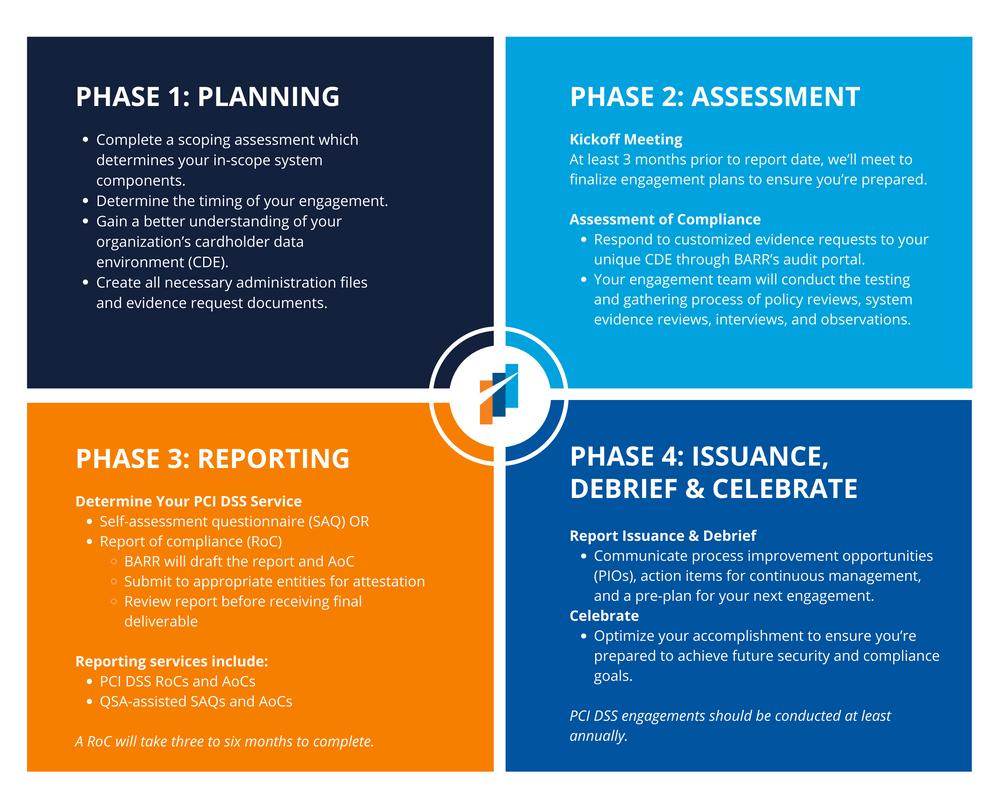
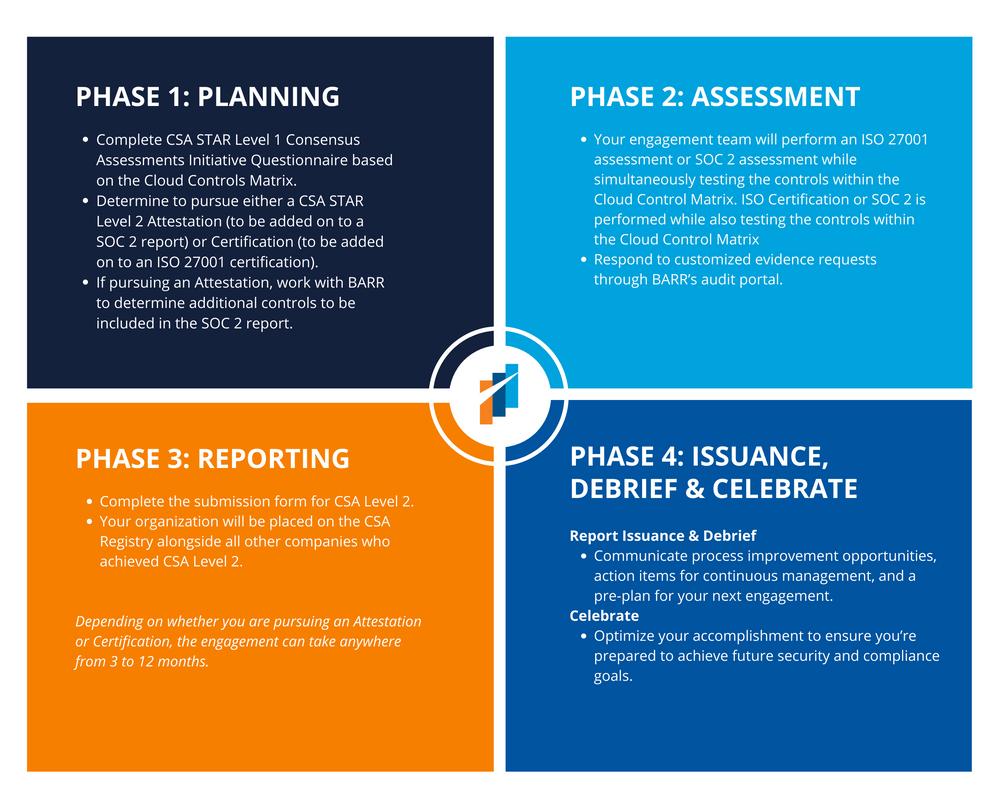
Client Post Engagement
OWNER TASK
Client Services
Client
Marketing
Client Services
Marketing
Marketing
Final Engagement Deliverable
Engagement team member sends the final deliverable (report and/or certification) to the client via email. Templated copy for the delivery email includes links to the satisfaction survey and promotional packages
Client Calls-to-Action
Client completes satisfaction survey
Schedules debrief with engagement team
Schedules Marketing consultation (if needed)
Marketing Consultation
Member of the marketing team conducts marketing consultation call with the client to share best practices in promoting the report and/or certification (if needed)
Shares additional resources and examples and talking points for sales teams
Expresses that SOC is NOT a certification
Offers to review any materials the client develops
Debrief Meeting
Engagement team conducts a debrief meeting to discuss the success of the recent engagement Plans future engagements, drafts ELs, begins scheduling resources
This is when the engagement manager would promote other services to the client as indicated in the satisfaction survey
Satisfaction Survey Review
The marketing team reviews every survey submitted
Any scores below 9 or comments in “What could we do better?” are reported to the Head of Attest Services and Head of Business Development
Positive comments are pulled for us as testimonials in marketing material
Net Promoter Score (NPS)
Every quarter, the marketing team pulls all client survey data and calculates BARR’s NPS
Calculated by: % Promoters (9s and 10s) minus % Detractors (1s-6s)
Quality
Quality Management System
Document QMS for new service lines based on relevant regulations from the accreditation body
Review and amend QMS during the annual internal audits or when ad hoc changes in process or regulations occur
Monitor and respond to changes in professional standards and regulation
Assist in team development to maintain compliance with the above
Engagement Feedback
Respond to questions about quality requirements, independence, or professional standards issues
Identify areas of opportunity for team training based on engagement quality reviews
EQCRs
Annual Internal Audits for the ISO and SOC Practice
Select an internal audit team
Select a sample of engagements (for ISO engagements must match the scope of our accreditation)
Review the QMS against relevant AICPA and ISO standards to ensure completeness
AICPA - QC 10, but soon to be SQMS 1 and 2 effective December 2025
ISO - ISO 17021, 27006, 27006-2, and MD requirements
Review sampled engagements against relevant requirements and BARR proven processes utilziing defined audit templates
SOC engagements are reviewed against the AICPA peer review checklist which outlines requirements from QC 10, the SOC guides, AT-C 105, AT-C 205, and AT-C 320
ISO engagements are reviewed against ISO 17021, 27006, 27006-2, and MD requirements
Document findings and add them to the corrective actions registry
BARR Advisory
BARR Certifications
Annual Internal Management Reviews for ISO and SOC
Identify stakeholders
Kickoff with review team
Review Risk Analysis
Gather review inputs (i e audits, corrective actions, feedback, complaints, etc )
Note - Explicit management review requirements are defined in ISO 17021 for BARR Certifications
Debrief with stakeholders
Coordinate response to results
Communicate results to the team
Peer Review Processes for SOC Clients
Select peer review firm
Schedule peer review
Coordinate office visit
Respond to peer review requests
Coordinate response to peer review findings
Communicate the results to the team
ANAB Office and Witnessed Audits
Schedule and coordinate visits with the ANAB
Coordinate with audit teams to ensure witnessed audits are completed per requirements
Respond to findings
Coordinate improvements in processes as needed
New Accreditation Support
Be the main point of contact at the accreditation body and determine requirements for accreditation
Obtain pricing and build out a new accreditation roadmap
Identify an Attest SME
Obtain approval from leadership
Complete application steps, documentation, and QMS updates
Respond to any accreditation body comments and requests until accreditation is obtained
Maintain any internal QMS, policies and procedures related to accreditation and be the liason for any required audits or reviews
Client Service Operations
Resourcing, Engagement Letters, and the Engagement Pipeline
New Business Pipeline
The Resourcing Coordinator is alerted that a new engagement is ready to schedule Resourcing Coordinator reviews team availability in Kantata and determines if the project is staffable in the times outlined in Hubspot (based on Attest and Ops availability)
If project can't be staffed, communicate to Biz Dev what can be staffed
Resourcing Coordinator selects and assigns a manager and adds template to project
Moves Deal to EL Ready for EL (automated notification to CS Ops)
The Proposal Specialist Creates an Engagement Letter based on the Deal information in Hubspot
Moves Deal card to EL Ready for Executive Review in Hubspot Executive (Partner or Director) reviews and updates as appropriate
Moves Deal to EL Ready to Send in Hubspot
EL is sent to the client and the deal is moved to EL Pending Sign off in Hubspot Manager will finalize task time estimates in Kantata and communicate to Resourcing Coordinator any resourcing preferences Manager also reviews Hubspot Deal information and updates if necessary (price, engagement period, engagement scope)
Resourcing coordinator updates task hours allocation per manager estimates utilizing [insert to be created allocation guide] and creates allocation for each resource on the project. Resourcing Coordinator will staff Associate and Senior project resources in Kantata.
Update project status in Kantata to Scheduled
Proposal Specialist will track the Deal weekly until the Deal is signed
Proposal Specialist creates invoices 1 and 2 and attaches them in Kantata Proposal Specialist releases the first invoice if due upon EL execution If a later date, the manager will release both invoices
Proposal Specialist adds EL to the file section of the project.
Recurring Engagement Pipeline
Proposal Specialist creates Deal in Hubspot and moves the deal to “ready to schedule” in Hubspot. Resourcing Coordinator gets notified and adds the appropriate template to Kantata project and assigns the prior year Manager If prior year manager is no longer a Manager, Resourcing Coordinator selects a new one
Manager finalizes task time estimates in Kantata and communicates to the Resourcing Coordinator any resourcing preferences. Manager also reviews Hubspot Deal information and updates if necessary (price, engagement period, engagement scope)
Moves Deal to Ready for EL in Hubspot
Resourcing coordinator updates task hours allocation per manager estimates utilizing [insert to be created allocation guide] and creates allocation for each resource on the project
Resourcing Coordinator will staff Associate and Senior project resources in Kantata Update project status in Kantata to Scheduled
Proposal Specialist creates EL in Hubspot
Moves Deal to EL Ready for Executive Review
Executive (Partner or Director) reviews and updates
Moves Deal to EL Ready to Send
Proposal Specialist sends EL to Client
Moves Deal to EL Pending Sign-off
Deal is signed
CS Ops creates invoices 1 and 2 and attaches them in Kantata. CS Ops releases the first invoice if due upon EL execution. If a later date, the manager will release both invoices.
CS Ops adds EL to the file section of the project
Reporting
Draft reports, Management Rep Letters, and click-thru text are created by the Reporting Specialist from approved templates in the template gallery 120 days prior to the report issuance date and puts the draft report into the client engagement folder on the shared drive and the other documents into the report production folder.
Assigned quality reviewer occurs 14 days before report issuance
Partner Review occurs ~ 5 days before report issuance
Editorial by the technical report specialist occurs ~4 days before report issuance
Cybersecurity Consulting
Invoicing and Engagement Financial Management
Objective: Ensure we receive timely payment for services provided and ensure an accounting of services is available to clients.
Note: steps 1 -3, and first two bullets under step 5 are owned by Finance, but included here for reference. Invoicing - Subscription Engagements
1.
Startup costs are invoiced as soon as the proposal is won If there isn’t a set startup cost, we send the first subscription invoice at this time
Monthly invoices are sent on the first of each month based on the agreed-upon fees in the SOW
Hours Overages are billed the same as hourly engagements
2. Invoicing - Hourly Engagements
New Engagements: Startup costs for hourly engagements will include two invoices:
Invoice #1: 50% of gap analysis and remediation fees upon proposal execution
Invoice #2: 50% of gap analysis and remediation fees immediately following the completion of the remediation activities
Ongoing Engagements:
Invoices are sent based on the hours incurred in the prior month, typically in the second week of the month.
The Director(s) review the hours on each invoice before sending. If necessary, the engagement team discusses the hour and any necessary changes are made to timesheets before finance sends the invoice
3 Invoicing - Other Fixed Fee Engagements
New Engagements: Invoices are broken down into two separate invoices as follows:
Invoice #1: 50% of the total engagement fees, sent upon execution of the proposal.
Invoice #2: 50% of the total engagement fees, sent immediately after the client approves the final deliverables
Engagements with multi-year agreements: fixed fee engagements (e g , internal audits), two invoices are sent as follows:
Invoice #1: 50% of the total engagement fees, sent immediately following engagement kickoff
Engagement status changes from “Pipeline” to “Confirmed or Scheduled”
Note: include estimated completion date for invoice scheduling
Invoice #2: 50% of the total engagement fees, sent immediately after the client approves the final deliverables
Engagement status changes from “In Progress” to “Completed”
Note: include estimated completion date for invoice scheduling
4. Monthly Invoice Review: The Director(s), in consultation with engagement teams, reviews time entries and invoices for accuracy. This review occurs prior to the first Friday of each month
Hourly Invoices:
Review the time entries with the engagement team
If necessary, time entries are adjusted
Do hours seem reasonable based on services provided?
Are hourly rates accurate per SOW?
Once reviewed, notification is sent to the invoicing team that hourly invoices are ready to send.
Subscription Invoices:
Ensure all new subscription engagements are included in the Projects Module within Kantata
Review each subscription invoice for accuracy per the SOW
Fixed Fee Invoices:
Reviews any fixed fee invoices to double check invoices for the next month are planned according to the “Fixed Fee Invoicing Process”
5. Financial Standing Review: The Director(s), during the first week of each month:
Reviews each client’s invoices payment status.
Identifies any clients who are more than 1. $10k and/or 2. Two months behind on payments
Discusses with the client
Communicates the results to the Finance team
If necessary, pauses services until a payment plan is reached
Quality Service
Objective: Deliver a service quality to our clients from deal close to the end of a relationship. Uncover engagement issues before they become severe issues.
Onboarding
1 Request access to client’s tools or systems, when required
3
Create shared folder or drive and share with client contact(s)
2 Update the Kantata project and resource allocations with hours forecast, resource assignments, and schedule hours
4.
Communicate invoice process to finance team and/or update Kantata accordingly
Note: if the client requires a SOW outside of Proposify (e.g., Docusign), download the signed proposal from the external tool and upload to Proposify
5 Send Intake Survey to client contact(s)
Client Feedback
1.
Engagement satisfaction (NPS) survey
New clients: send survey once remediation is completed
Ongoing clients: after each external audit or major initiatives
Internal audits: after each IA deliverable is provided
2.
Formal Check Ins
The Director(s) on a quarterly basis meets with client engagement sponsors to:
Discuss quality of services delivered
Issues with engagement team, services, or deliverables
Potentially new security and compliance initiatives
Changes to budgets
Annually: See “Annual Budget and Feedback Review” process
Once above are completed, the Director(s)
Discusses feedback with engagement teams
Updates engagement forecasts and schedules
Communicates changes to Finance team, if necessary
3
Ad-hoc Check Ins:
The Director(s) will, on an as-needed basis:
Periodically join status calls
Chat via Slack or other messaging platforms
Call the client project sponsors directly
4.
Communication with Engagement Teams
The Director(s) will communicate any feedback, budget changes, or other relevant matters to the engagement team during:
Weekly Pulses
Monthly 1:1s
Direct phone calls
Slack messages
Client feedback will factor into team members’ annual performance reviews
If necessary, coordinate with the Learning and Development team to create training plans based on feedback
Annual Budget and Feedback Review
Director(s) meet with client contact(s) annually to: 1.
Gather feedback on engagement performance (see Client Satisfaction process) and confirm: Budget based on existing services provided and additional services planned for/needed in subsequent year
Invoicing approach - either hourly or subscription
Discuss feedback and proposed budget with team
Create new opportunity(ies) in Salesforce
If necessary, create new SOW and send to client for signature if:
Hourly rates change
Invoicing approach changes
Existing SOW is out of date
Update Kantata
Assign engagement resources in the project setup screen
Ensure the billing configurations are set up according to whether the engagement is hourly or fixed/subscription.
Update Kantata’s allocation to reflect budget in the Resource Center
Individual team members update their schedules according to forecast
Engagement status
Offboarding
1
The Engagement Manager(s):
Removes all client access to BARR’s shared drives and other tools
Reviews contractual agreements to ensure all required documents and data are retained and provided to the client.
2. The Director(s) and Finance team:
Ensures payments are received for all services delivered.
3 The Director(s):
Gathers feedback from the client; and, Communicates that feedback to the engagement team
4. The Engagement Manager(s) archives the engagement in taskBARR.
Knowledge Base Management
1
All Core and Proven processes reside in Guru under the “Consulting” collection
2. Director, Cybersecurity Consulting Manager, Cybersecurity Consulting
3
4
All Core and Proven process cards should be verified by at least one of the following job roles when the card is initially published, at least annually, and any time the processes change.
All Cybersecurity Consulting team members must review Core and Proven process cards at least annually, but more frequently as part of their day-to-day responsibilities
Periodic trainings should cover these Core and Proven processes, including any significant updates in the past quarter
5. Scheduling and Forecasting
All Cybersecurity Consulting new hires and transfers must review and acknowledge the Core and Proven process cards within the first two weeks of employment
Objective: To ensure engagements are scheduled sufficiently with a team that provides the skills required for each client’s individual needs while ensuring team members are deployed according to department targets.
1.
New engagements
Engagement status moves to “Scheduled or Confirmed” in Kantata
Director(s) or Manager(s)
Allocate the budgeted hours in the Resource Center Kantata
Assign engagement resources
Note: at least a manager and engagement lead
Communicate resource assignments to team members
Team members update their individual schedules
Director(s) or Manager(s) review forecasts against schedules to ensure engagements are adequately scheduled.
2
Ongoing engagements
Manager(s) or Director(s):
Confirm annual budget with client and engagement team
Create a new engagement in Salesforce with the correct year in the name
Update the allocations in Kantata’s Resource Center with budgeted hours/mo.
Subscription Engagements: is simply the monthly subscription cost divided by $290 (e.g., $5,000 subscription is 17 hours/month)
Hourly Engagements: based on discussion with the client and engagement team and should closely reflect an the engagement team’s schedules so as to ensure revenue and hours forecasts match the timing of services throughout the year
Fixed Fee Engagements: Hours are forecasted according to the timing of the engagement, which will generally take place over 1-2 months (e.g., internal audits, one-off gap/risk assessments)
Assign engagement resources as described above
Communicate resource assignments to team members
Team members update their individual schedules
Director(s) or Manager(s) review forecasts against schedules to ensure engagements are adequately scheduled.
Project Forecast Reviews: 3.
Manager(s) or Director(s), on a monthly basis:
Review the monthly forecast
If necessary adjust the Resource Center to reflect changes
Communicate changes to engagement teams
Director(s), on a quarterly basis,
Review budgets with client and engagement teams
If necessary adjust the Resource Center to reflect changes
Communicate changes to engagement teams
Individual Responsibilities: 4
Each team member is responsible for:
Their own schedules once assigned to an engagement
Reviewing their schedules monthly and updates them according to client needs, changes in priorities, PTO, etc.
Ensuring their schedule is aligned with deployment rate targets and raises issues with performance managers as soon as possible
Notifying Manager(s) and Director(s) of material changes to schedules and client priorities so they can make necessary changes to the engagement scope and contracts
People & Culture
Recruiting
Define role, job description, salary, and update accountability chart
Decide sourcing strategy (external, internal, both) and mediums (LinkedIn, Partner Channels, Apprenti, Campus, etc.)
Seek employee referrals
Resume reviews
Interviewing
30 minute phone screen by recruiter
2 minute video submission review
Candidate Mock Exercise
Team rounds
Values interview (practice leader/VP/managing partner)
Reference and background check
Track activities in Rippling ATS
Onboarding
Onboarding checklist created by P&C
Trello Board & peopleBARR
BARR Buddy
Manager Checklist
30/60/90 day check ins
Intro sessions with People & Culture and Marketing
V/TO Review with CEO
Performance Management
Accountability Chart and Job Descriptions
Creating Smart Quarterly Rocks
Quarterly Promotion & Transition Process
Performance Management
Who We Measure: Our Employees
Why We Measure: Right People + Right Seats + Continued Focus on Employee Development
What We Measure: Using our VIP Performance Management Tool, continuously measure (V) values alignment, (I) impact/performance, and (P) plan
BARR’s Five Step Performance Management Process:
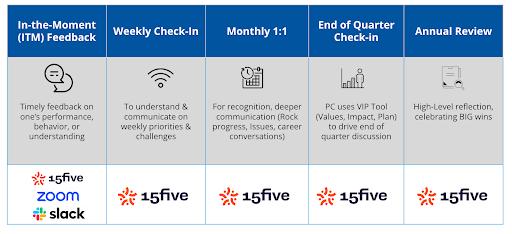
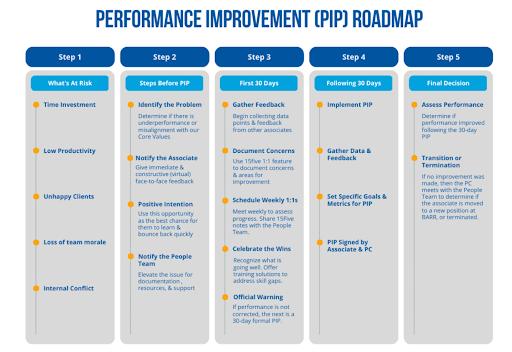
People & Culture Annual Events
February: Annual Employee Reviews
March: Compensation Reviews
April: Compensation changes take effect
September: Annual Employee Engagement Survey
December: Benefits open enrollment
Learning and Development
Needs analysis types and techniques
Training program design and implementation
Developmental assessments
Goal-setting best practices
Career development techniques
Knowledge-sharing programs and facilitation
Leadership development and planning
Approaches to coaching and mentoring
Employee & Community Engagement
People & Culture Annual Calendar
Love Month
March Volunteer Madness
Camp BARR
Raising the BARR 5k
Annual Day of Giving
Holiday Party
BARR Matching Gift Program
Volunteer Paid Time Off Program
Brand Strategy, Marketing, and Strategic Communications
Brand and Content Management
Brand and Content Management
A request is created in Asana by marketing or a BARR employee fills out a creative request form accessible through Asana
Content types include whitepapers, case studies, fact sheets, sales enablement materials, blogs, slide decks, videos, etc.
Standard turnaround times range from 1 to 10 business days depending on the content type.
Marketing internal review
External stakeholder or BARR employee review, as needed.
Internal content posted in Guru (i e , marketing resources folder) Blogs and other external content stored in marketing drive and posted externally
Asana ticket closed
PR and Media Relations
mediaBARR
See mediaBARR sign-up sheet
1. BARR subject matter experts (SMEs) indicate in the thread if they plan to respond, then send their response to the PR and media relations marketing associate before the deadline.
The PR and media relations marketing associate identifies relevant opportunities and shares them in the #pr-media-barr channel on Slack.
2. The response is edited, then shared with the director of marketing for review before submission
3
4 Past mediaBARR responses are stored within the Root folder.
The PR and media relations marketing associate notifies the associate if their response is accepted If the response is rejected, it is saved in the Quote Bank to be repurposed for other marketing content
Press Releases
See our press release calendar for upcoming press releases.
Press Releases Process
1
The PR and media relations marketing associate works with relevant SMEs to draft the press release using this template.
From there, press releases follow BARR’s standard process for creative deliverables. (See Guru card.)
3.
2. Upon approval, the PR and media relations marketing associate submits the press release to Business Wire and schedules the press release to publish on BARR’s blog
4
After distribution, the PR and media relations marketing associate logs performance metrics within this spreadsheet
Press release drafts are stored within the Root folder.
Award Nominations
See our industry awards calendar for upcoming nominations.
Nomination Process
2.
1. The marketing team drafts all content associated with the award and coordinates recommendation letters, references, etc Award content follows BARR’s standard process for creative deliverables (See Guru card )
3
The marketing team identifies awards and selects eligible associates, teams, or projects to nominate.
If applicable, the associate being nominated reviews any drafts for accuracy
The marketing team submits the nomination.
4. Award nomination form drafts are stored within the Root folder.
Finance and Business Support (source)
Invoicing
Tools/resources: Quickbooks, TaskBARR, Proposify, Salesforce
Client Portals: Workday, Coupa Supplier Portal, Beeline, Tipalti-G2
Engagement letter or statement of work is agreed to by client and executed by BARR and client Salesforce is marked as “won” and TaskBARR phase is moved to “plan” - this tells accounting that an engagement is ready to invoice
Accounting manager reviews the finance dashboard in TaskBARR to identify new engagements ready to be invoiced
Invoices for existing clients are created in Quickbooks under the existing client profile Invoices for new client, a client profile is created in Quickbooks (Advisory client data is imported from Proposify, Certifications clients are manually entered)
Engagement letters must be signed prior to invoice creation. Accounting verifies signature on engagement letter in Kantata
Payment schedule and amounts are dictated by the terms in the engagement letter
All invoices are associated with the engagement in TaskBARR for reconciliation purposes
Invoices ready to be sent to clients are reviewed weekly and sent from Quickbooks or are uploaded to a client portal
A/R Management
Tools/resources: Quickbooks, Arvest Cash Manager, Arvest Lock Box, Microsoft Excel
Forms of payment that are accepted by BARR are: Check, Credit Card, ACH, or Wire
Checks are mailed to a lockbox at Arvest Once received at the lockbox, checks are automatically deposited into BARR Advisory’s account at Arvest
Credit card payments are facilitated through Melio or Bill com Melio and Bill com charges the client a fee for using this service
ACH and Wire payments are received directly in the Advisory or Certifications account at Arvest
Once payments are deposited at Arvest they are matched by the Accounting Manager with open invoices in Quickbooks
The A/R aging report is monitored weekly using an excel spreadsheet from a Quickbooks report
Accounts that are 1-30 days are contacted by the finance team as a reminder that payment is due
Accounts that are 31-60 days past due are sent to the engagement manager for a first escalation.
Accounts that are in excess of 60 days past due are reviewed by the finance and engagement team.
Communication must be established with the client with an explanation for the past due payment. If the client is not responsive or unwilling to make payment services are halted under the client is able to become current on invoices outstanding
Final Engagement Reports or work product is not released until all outstanding invoices have been paid
A/P Management
Tools/resources: Bill.com, Rippling Spend Management
BARR utilizes two primary forms of payment for employee expenses: Bill.com and Corporate Credit Cards managed via Rippling Spend Management
Bill com is used for vendor payments made via check/ACH and other employee expenses where a credit card is not an accepted form of payment Payments scheduled through Bill com are scheduled for payment on the invoice due date
A physical credit card is issued to each employee and a virtual card is issued to each department
Physical cards are used by employees for business expenses necessary for performance of their job.
Virtual cards are issued to each department for vendor charges and recurring expenses.
Payments scheduled through Bill.com or credit card must include a memo with a description of the charge and a receipt is required for expenses greater than $25
Treasury Management
Tools/resources: Arvest Cash Manager
BARR has a banking relationship with Arvest Bank
BARR has five separate accounts at Arvest:
BARR Advisory checking account (4300)
BARR Certifications checking account (8917)
BARR Ventures checking account (8409)
BARR Advisory A/R (4362)
BARR Advisory sweep account (6224)
Payments for BARR Advisory services are deposited in account 4300, or account 4362 and then swept nightly into account 4300
Payments for BARR Certifications services are deposited in account 8917
Excess cash in BARR Advisory account 4300 is swept into the BARR Advisory Sweep account 6224, where it is able to earn interest.
BARR Ventures is the employing entity for BARR employees and some contractors. Payroll is paid through BARR Ventures, account 8409 BARR Ventures charges BARR Advisory and BARR Certifications two fees:
Compensation Fee for the cost of the salary and benefits of employees performing work on each entity’s behalf
Management Fee for employment management services and back office services
BARR has a line of credit open with Arvest that is collateralized by BARR’s receivables. The maximum amount that can be drawn on the LOC is $1 million
Budgeting, Forecasting, and Communication
Tools/resources: Quickbooks, Microsoft Excel, Xero, Arvest Cash Manager
BARR performs an annual budget and forecasting exercise
The budgeting and forecasting process begins at the start of the fourth quarter and is completed by December 31st
Each department leader is provided with a summary of its historical expenses incurred over the past year as a reference for recurring expenses
The leader of each department is asked to forecast those recurring expenses along with any personnel changes and new expenses or investments required to support the Company’s strategic and financial objectives.
The budget and forecast of each department is sent to the Vice President of Finance and the Accounting Manager The Accounting Manager consolidates each department’s budget into a consolidated view to show the forecasted performance of the Company
The Leadership Team reviews the consolidated forecast to ensure the forecasted performance is in alignment with the stated financial and strategic goals for the period
The actual financial performance is reviewed alongside the forecasted performance of the Company by department and on a company wide basis monthly
Entity Consolidation for Financial Reporting
Tools/resources: Quickbooks, Microsoft Excel, Xero, Arvest Cash Manager
BARR consolidates the financial performance of its three entities (Advisory, Certifications, and Ventures) on a monthly basis.
The monthly income statement and balance sheet for BARR Advisory, and BARR Certifications are taken from Quickbooks, and the income statement and balance sheet for BARR Ventures is taken from Xero.
The income statement and balance sheet of each entity are recorded and consolidated in Microsoft Excel and tracked over the course of the fiscal year
Taxes
Tools/resources: Quickbooks, Xero, Rippling, Arvest Cash Manager, Hutchins & Haake LLC
BARR’s annual tax filing and quarterly payment estimates are prepared with assistance from our tax advisor, Hutchings & Haake LLC
Payroll
Tools/resources: Rippling, Arvest Cash Manager
Currently, payroll is monitored periodically in Rippling to ensure that deductions and withholdings are are properly completed for payruns
Assist People and Culture with registration of new hires in states where BARR is not currently registered
Respond to tax notices from the IRS and States by either using Rippling support or completing the needed actions
At the end of each month, reconcile payroll deductions and withholdings in Rippling with the payroll liability accounts in Xero
Entity Management and State Compliance
Tools/resources: Capitol Services, Joel Krieger
Finance and Business Support team ensures that BARR Ventures, Advisory and Certifications are registered and in good standing with state authorities where it has employees and ensures that the Firm is compliant with local CPA board of accountancy laws
BARR Ventures must be registered to do business in every state where it has an employee BARR utilizes Capital Services to assist with state registration and compliance. This relationship is managed by the Accounting Manager
BARR Advisory must be compliant with local CPA board of accountancy laws. The NASBA is monitored for Firm requirements and individual CPA license requirements.
Compliance is reviewed and monitored quarterly
BARR’s attorney specializing in CPA compliance law is Joel Krieger
IT Provisioning
Tools/resources: Complete Technology
New access
Access is pre-provisioned by role upon onboarding
Access needed beyond pre-provisioning must be approved by a manager
Asset Management
Complete Technology will send access reports to the owner of each asset for review quarterly

